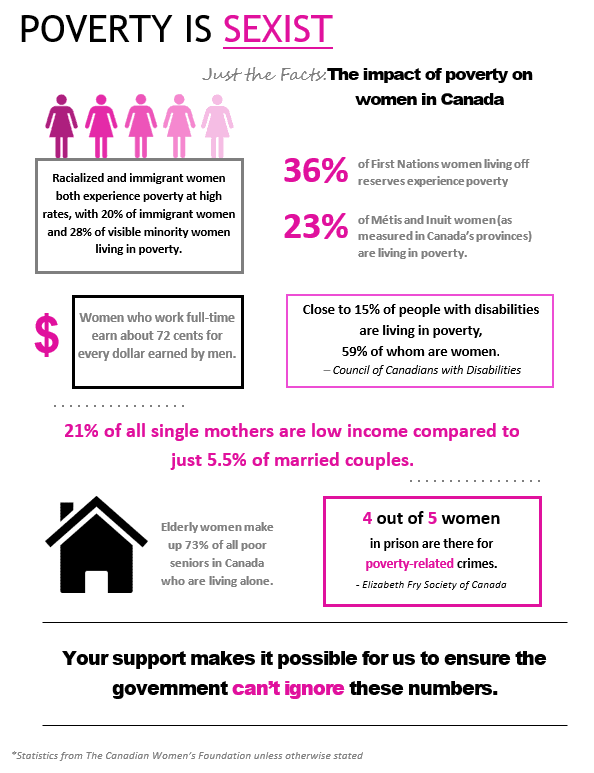Homelessness Among Women and Gender-Diverse People
Experiences of Homelessness
Women’s experiences of homelessness are unique and different from men. A recent study of the state of women’s homelessness found that housing services and supports for women and gender-diverse people are inadequate. There are not enough women-only shelters to accommodate their short-term housing needs. This lack of gender-specific shelter beds puts women at risk who are living in situations of poverty and abuse. The study also concluded that mainstream housing services and programs do not provide the necessary supports for women and gender-diverse people to transition out of homelessness into stable housing (Schwan et al., 2020).
Poverty is a significant risk factor for experiencing homelessness. Women and gender diverse people are more likely to live in poverty than men for a variety of reasons.
Image: Just the Facts: Poverty in Canada. Canada Without Poverty.
Core Housing Need
- 28% of women-led households are in core housing need compared to 16% of male-led households (CMHC, 2019)
- 21% of single mothers in Canada are raising their children in poverty (Canada Without Poverty).
- Close to 70,000 women and children accessed domestic violence shelters in one year (Stats Can, 2019).
- 42% of women living on reserves live in houses that need major repairs (Statistics Canada, 2017).
What do you think?
Which of these statements are TRUE?
- Women experience precarious housing as a result of violence, discrimination and poverty.
- Women’s homelessness is overestimated because their experiences are often hidden.
- Women and gender diverse people access emergency shelters about as often as men.
CHECK ANSWER
TRUE:
Women with low income and marginalized women have a greater risk of homelessness as a result of structural inequities such as poverty and violence.
For some people, the experience of homelessness is brief, and they are able to return to stable housing after a single episode. However, for others exiting homelessness and exiting the cycle of poverty can be a complex challenge.
References
Canada Mortgage and Housing Corporation. (2019). Core Housing Need Data — By the Numbers. CMHC–SCHL.gc.ca
Just the Facts: Poverty in Canada. (2021) Canada Without Poverty/Canada Sans Pauvreté. Retrieved June 21, 2021 from https://cwp-csp.ca/poverty/just-the-facts/
Schwan, K., Versteegh, A., Perri, M., Caplan, R., Baig, K., Dej, E., Jenkinson, J., Brais, H., Eiboff, F., & Pahlevan Chaleshtari, T. (2020). The State of Women’s Housing Need & Homelessness in Canada: A Literature Review. Hache, A., Nelson, A., Kratochvil, E., & Malenfant, J. (Eds). Toronto, ON: Canadian Observatory on Homelessness Press.
Statistics Canada. (2015). Aboriginal Statistics at a Glance: 2nd Edition. Retrieved June 9, 2021, from https://www150.statcan.gc.ca
Statistics Canada. (2017). The Housing Conditions of Aboriginal People in Canadian Housing Survey, 2018. Retrieved June 9, 2021, from https://www150.statcan.gc.ca
Statistics Canada. (2019). First results from the Canadian Housing Survey, 2018. Retrieved June 9, 2021, from https://www150.statcan.gc.ca

